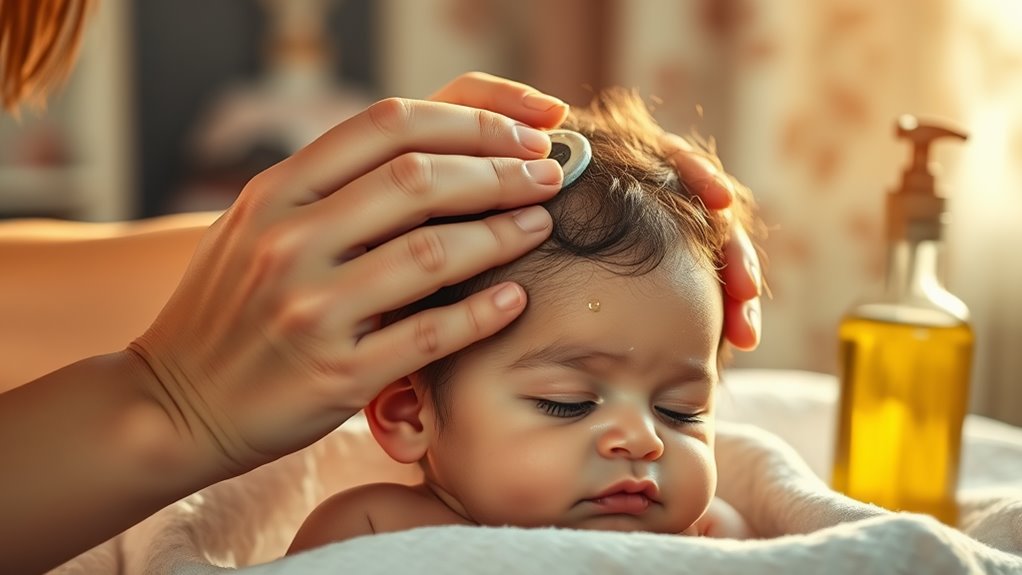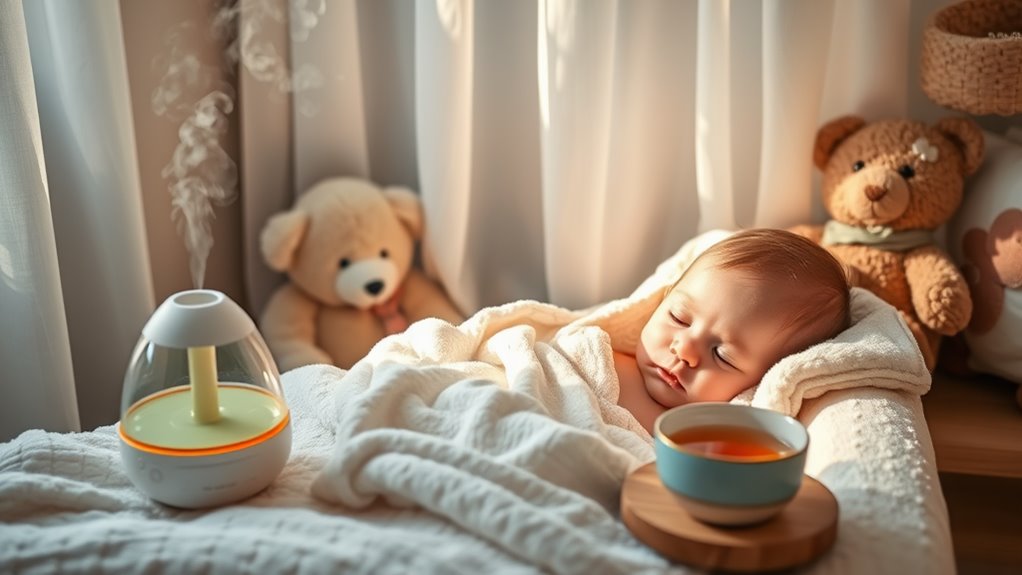Ease Cradle Cap With This Oil Massage Tip
To ease cradle cap, try an oil massage on your baby’s scalp. Use gentle natural oils like coconut, olive, or sunflower oil for soothing moisture. Warm the oil slightly, then apply it with your fingertips in circular motions for 5-10 minutes. This not only relieves irritation but also promotes scalp health and hair growth. Remember to monitor for any unusual changes, and you can discover more tips to support your baby’s scalp health.
Key Takeaways
- Cradle cap is a common condition in infants that typically resolves on its own within weeks to months without causing concern.
- An oil massage using gentle, natural oils like coconut or olive oil can help soothe irritated skin and promote scalp health.
- Warm the oil slightly, apply it to the scalp, and gently massage in circular motions for 5-10 minutes to alleviate flakes.
- After the massage, use a soft brush to help remove loosened flakes and enhance the effectiveness of the treatment.
- Monitor for signs of infection or persistent symptoms; consult a pediatrician if conditions worsen or do not improve.
Understanding Cradle Cap
Cradle cap, also known as seborrheic dermatitis, often appears as greasy, yellowish patches on your baby’s scalp. This condition is common and usually harmless, affecting infants within their first few months.
You might notice flakes or crusts that can be concerning, but rest assured, it typically resolves on its own. To help manage cradle cap, consider using cradle cap remedies like gentle shampoos or oil treatments. These can soften the scales, making it easier to remove them.
Regular washing with a mild shampoo can also prevent buildup. Remember to consult your pediatrician if the condition worsens or shows signs of infection. Your baby’s comfort and health are paramount, so addressing cradle cap promptly is essential.
Benefits of Oil Massage
Oil massage can greatly promote your baby’s scalp health by providing essential moisture to combat dryness.
Additionally, it soothes irritated skin and can help alleviate discomfort associated with cradle cap.
Enhanced blood circulation from gentle massage also plays an important role in nourishing the scalp and encouraging healthy hair growth.
Promotes Scalp Health
While managing cradle cap can be challenging, incorporating an oil massage into your routine can markedly promote scalp health.
Regularly massaging oil into your baby’s scalp not only helps loosen flaky skin but also enhances nourishment, providing essential benefits:
-
Improved circulation: The gentle pressure stimulates blood flow to the scalp, promoting healthy hair growth.
-
Moisturization: Oils help maintain the scalp’s natural moisture barrier, preventing dryness and flakiness.
-
Balanced oil production: Massaging can help regulate sebum production, maintaining an ideal environment for scalp health.
Soothes Irritated Skin
When your baby experiences cradle cap, you might notice signs of irritation and discomfort on their scalp. This irritation can lead to redness, flakiness, and even itchiness, making your little one fussy.
An oil massage can help soothe this irritated skin effectively. Using a gentle, natural oil like coconut or olive oil not only moisturizes the scalp but also calms inflammation. As you massage the oil into your baby’s scalp, it creates a protective barrier, preventing further irritation.
The soothing properties of the oil can alleviate discomfort, allowing your baby to feel more at ease. Regularly incorporating this practice can promote a healthier scalp and improve your baby’s overall comfort, making those tough moments a little easier for both of you.
Enhances Blood Circulation
As you massage your baby’s scalp, the gentle pressure and movement of your fingers can considerably enhance blood circulation.
Improved circulation not only promotes healthier scalp skin but also aids in nutrient delivery to hair follicles. This can help in alleviating cradle cap and supporting overall scalp health.
- Boosts oxygen supply to the scalp
- Encourages hair growth by nourishing follicles
- Reduces tension and promotes relaxation
Incorporating regular oil massages into your routine can create a nurturing environment for your baby’s scalp.
As blood flow increases, it supports healing and helps to prevent further skin issues. This simple yet effective practice fosters a bond between you and your baby, making the experience both therapeutic and rewarding.
Choosing the Right Oil
Choosing the right oil for treating cradle cap can greatly impact your baby’s comfort and skin health.
Look for natural, gentle oils that won’t irritate sensitive skin. Coconut oil is a popular choice due to its moisturizing properties and antibacterial benefits, which can also contribute to improved gut health. Olive oil is another excellent option, known for its soothing qualities.
If your baby has a history of allergies, consider sunflower oil, which is hypoallergenic. Always avoid mineral oils and products with synthetic fragrances, as these can exacerbate skin issues.
Test a small amount on your baby’s skin first to verify there’s no adverse reaction. Additionally, using oils with antibacterial benefits can help ensure a healthier scalp environment for your baby.
Step-by-Step Oil Massage Technique
Once you’ve selected the right oil for your baby’s cradle cap, it’s time to apply it effectively. Follow these steps to guarantee a gentle and thorough massage:
- Warm the oil slightly in your hands to enhance absorption.
- Use your fingertips to apply the oil, focusing on areas with flakes.
- Massage in circular motions for 5-10 minutes to stimulate the scalp.
This technique not only helps soften the scales but also promotes blood circulation in your baby’s scalp, which can aid in healing.
Be gentle to avoid causing any discomfort. After the massage, you can use a soft brush to help remove loosened flakes.
Consistent application can make a significant difference in managing cradle cap.
Tips for Maintaining Scalp Health
To keep your baby’s scalp healthy and minimize the chances of cradle cap recurring, it’s essential to establish a consistent care routine.
Begin by gently washing your baby’s scalp with a mild, fragrance-free shampoo two to three times a week. This helps remove excess oil and build-up without irritating the skin.
After washing, consider applying a light, non-comedogenic oil to maintain moisture. Regularly brushing your baby’s scalp with a soft-bristled brush can also stimulate circulation and remove flakes.
Make sure your baby’s environment is humidity-friendly, as dry air can exacerbate scalp issues.
Finally, keep an eye on any changes in your baby’s scalp condition, as early intervention is key to maintaining scalp health.
When to Consult a Pediatrician
If your baby’s cradle cap symptoms persist despite your efforts at home, it’s important to consult a pediatrician.
Additionally, keep an eye out for signs of infection, such as redness, swelling, or discharge, as these warrant professional evaluation.
Addressing these concerns promptly can help guarantee your baby’s comfort and health.
Persistent Cradle Cap Symptoms
How can you tell when cradle cap might be more than just a minor annoyance?
It’s crucial to recognize persistent symptoms that warrant a consultation with your pediatrician:
- If the cradle cap persists beyond a few months without improvement
- If there’s significant redness or swelling in the affected area
- If the scales seem to be spreading to other parts of your baby’s body
While cradle cap is generally harmless, these signs might indicate a need for further evaluation.
Your pediatrician can help determine if treatment is necessary or if another underlying condition may be involved.
Always trust your instincts; if you’re concerned, don’t hesitate to reach out for professional advice.
Your baby’s comfort and health should always come first.
Signs of Infection
Recognizing signs of infection is vital when dealing with cradle cap, as some symptoms may signal a more serious issue requiring prompt medical attention.
Look for increased redness, swelling, or warmth around the affected area. If you notice pus or yellow crusts developing, it’s important to consult your pediatrician.
Additionally, if your baby shows signs of discomfort, such as excessive fussiness or crying, don’t hesitate to seek help. A persistent fever can also indicate an infection, warranting immediate medical evaluation.
Remember, while cradle cap is often harmless, staying vigilant about these signs guarantees your child receives the appropriate care.
Trust your instincts; if something feels off, reach out to your healthcare provider for guidance. Your baby’s health is the priority.




